Budding Bairnsfather, Blighty Magazine and Cheery Tommy Atkins by Robert St.John Smith
- Home
- World War I Articles
- Budding Bairnsfather, Blighty Magazine and Cheery Tommy Atkins by Robert St.John Smith
[This article first appeared in the August 2023 issue of Stand To! No. 131].
My dissertation examined soldier–drawn cartoons to find out what they could reveal about not only how humour was employed as a coping mechanism, but also what they said about both popular culture and the image of ‘Tommy Atkins’. This was achieved by surveying 820 British and Dominion soldier–drawn cartoons in trench journals, unit magazines, hospital journals, autograph books, personal ephemera and the soldiers’ paper Blighty: A Budget Humour from Home. The 181 cartoons that were captured in the latter will be discussed in the context of how they feed the popular image of the ‘Cheery Tommy’, understood by both contemporary and modern writers – of which there is no shortage of examples, ranging from Bird in his 1917 study of the Tommy, to the 2022 book Laugh or Cry.1
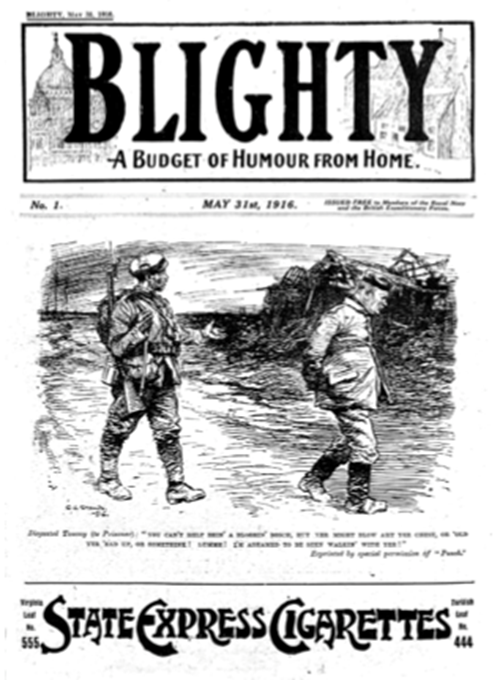
Peter Burke (2001) has rightly observed that ‘images are an important tool in reconstructing the past’, and as Thomas Milton Kemnitz (1973) argued, cartoons can be an important historical source.2 As a medium, cartoons have some uncommon strengths as a form of evidence, one of the strongest being amplification – the abstraction of a theme that the artist wants the viewer to concentrate on, such as drawing the backpack of a soldier several times larger than reality to emphasise its weight.3 Cartoons have been used most notably in the field of imagological studies, which have been more prominent in continental Europe than English speaking nations.4 Studies undertaken on the First World War have tended to focus on political cartoons, or have examined cartoons through a culturally historical lens, most notably by Jane Chapman and Daniel Ellin.5
The cartoons analysed in the survey were treated with the same rigour as any other historical source and a methodology – built on the foundations of the method used by Wolfkang Hünig in Cartoons as Weapons – was developed so that the cartoons could be plotted onto a statistical matrix.6 This approach allowed for a high volume of cartoons to be examined and compared, avoiding the pitfall of ‘picking a narrative’ by allowing the data to drive the analysis.
In practice, the matrix can be broadly broken down into three components. The first recorded the meta–data – details like the date, cartoonist, theatre and text. The second recorded the make– up of the cartoon – for example the setting, the dramatis personae and any influences behind it, such as a music–hall sketch (Figure 2). The third covered the themes featured in the cartoon, such as a chaff at authority or grouse about rations – and themes were not necessarily mutually exclusive in this regard.
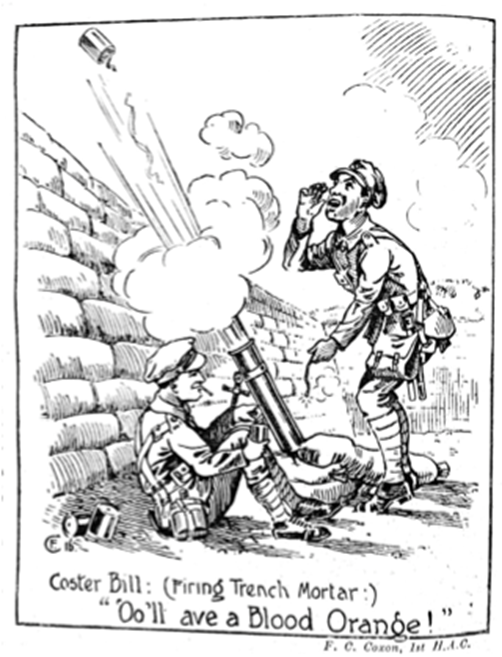
In total each cartoon was plotted against 207 data points. As the data was on a matrix, it was then possible to role–up the cartoons and, with the use of some statistical approaches, identify patterns and correlations.7 One of the more surprising revelations this approach revealed was the strong relationship between language, emotion and location, and, like soldiers’ letters, soldier–drawn cartoons changed with their audience. Blighty is a special case in this regard, being drawn by soldiers for other soldiers – but with civilian editorial oversight.
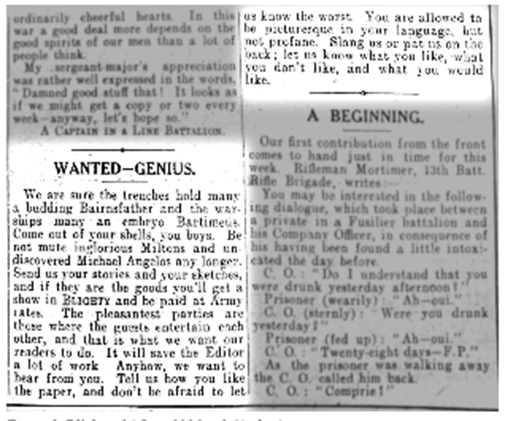
Blighty: A Budget of Humour from Home, originally to be subtitled ‘Life and Laughter at Home’, was a charitable soldiers’ newspaper that began publishing in May 1916 under the editorship of JE MacManus.8 MacManus, whose previous career was as a solicitor, was a journeyman playwright, songwriter and at one point on the editorial staff of both the Daily Mail and the Daily Express newspapers.9 In the foreword for the first issue, the origin of the magazine was attributed to an unnamed journalist inspired by letters from his two sons at the front asking for reading material. Wondering how to help, he consulted other associates with the idea of taking the best jokes and articles from across publications, cutting them together and reprinting them to send to the troops at no cost. The idea found patronage in the likes of Sir John Jellicoe and Sir John French and public subscriptions were raised to print the first few editions. The War Office and the YMCA, among others, were involved in its distribution, with the former arranging to send the first 40,000 copies directly to the trenches. The first few issues were made up entirely of material from the likes of Punch, Tatler and the Bystander, with the editors being happy to provide material ‘as long as it wasn’t sold for profit’.10 On 14 June 1916, a call for material from servicemen appeared (Figure 3) and this was to be the beginning of a regular two–page feature titled ‘From the Fleet and the Trenches’, featuring soldiers’ and sailors’ stories, along with their cartoons, poems and limericks. The feature normally presented two cartoons – the best would receive a guinea, and the second–best half a guinea – the same amounts were also offered to contributors of stories and jokes.11 It is reported that some six million copies were distributed over the two and a half years of its existence, a weekly–circulation of around 70–80,000.12 Blighty stopped being distributed free to troops on 5 March 1919 and became a commercial venture before declaring bankruptcy a year later.13
Behind this ‘charitable’ venture, research has uncovered a more questionable side to the publication: an early estimation of printing costs and paper for the magazines was given of around £300 per a week.14 Charitable donations to the magazine were regularly in the region of twice that amount, plus the magazine attracted a wide range of well–known advertisers, no doubt generating a significant income.15 Concerns about the publication were first raised in 1917, around a lack of access to its accounts considering its status as a war charity.16
Some of the other individuals involved in the publication are worthy of further examination: the Chairman was Ramsay Colles, a largely forgotten figure who, over a decade earlier, had a libel case brought against him and his magazine the Figaro, by the Irish revolutionary Maud Gonne, which he lost. There were rumours that both his magazine and legal costs were financed by Dublin Castle.17 The day–to–day management of Blighty was the responsibility of James Leadbetter Mackenzie, and later his son, Douglas. Both were involved in running coupon pool scams at the turn the century where they would advertise high cash prize competitions but claimed the prizes themselves under aliases.18 In addition, on the board was the publisher George William Macey, who was a director on a myriad of companies at 40 Fleet Street – where the magazine was based – and sat on the board of Blighty’s sister magazine Sea–Pie. Macey was fined by the Inland Revenue for war profiteering in 1919 and further concerns against his companies were raised post–war relating to the commercialisation of material that had been submitted by soldiers and sailors being reused in compilations and annuals. However, as the soldiers and sailors had been paid, no law was found to have been broken and no protest was made when Douglas Mackenzie relaunched Blighty during the Second World War.19 There is certainly more to be uncovered about the magazine (including a highly suspect share issue), but it is reasonable to assume that their motivations were financial – a point which will be returned to below.
The periodical, however, proved to be an immense resource for cartoons. Of the 181 which were included, covering the period from June 1916 to December 1918, contributions came from, where identifiable, 56 privates, seven corporals, 12 sergeants, five lieutenants and three captains, along with those from drivers, stretcher–bearers, sappers and gunners.
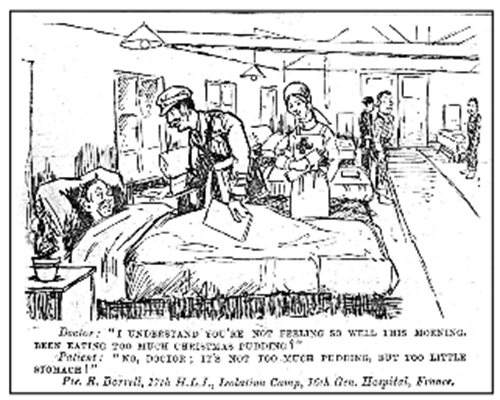
Birrell, 17th (Service) Battalion, Highland Light Infantry, who served on both the Western Front and in the Middle East, and was one of two cartoonists for the battalion’s magazine, the Outpost. One of the most prolific artists to feature overall, and described as a ‘real trojan’ by his peers, he also drew and redrew cartoons on behalf of other soldiers. Even being injured at the end of 1916 (Figure 4) had little effect on his output.20 Private Percy Cannot was the ‘camp cartoonist’ for the 10th (Stockbrokers) Battalion, Royal Fusiliers (City of London Regiment); he would go on to win the Military Medal (1916) for volunteering to undertake ‘a particular dangerous service’.21 In addition, he was one of the 40,000 soldiers of the British Jewish community to fight.22 Blighty also attracted contributions from far and wide, with submissions from the likes of Second Lieutenant Harry Cotton, a field meteorologist for the Fourth Army. In the mass of meteorological charts and other scientific paraphernalia in his papers is a single issue of Blighty, featuring a cartoon drawn by himself.23
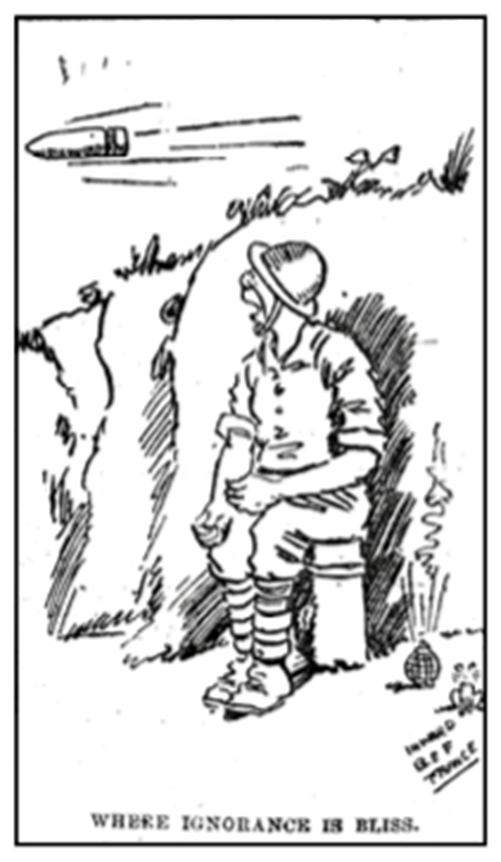
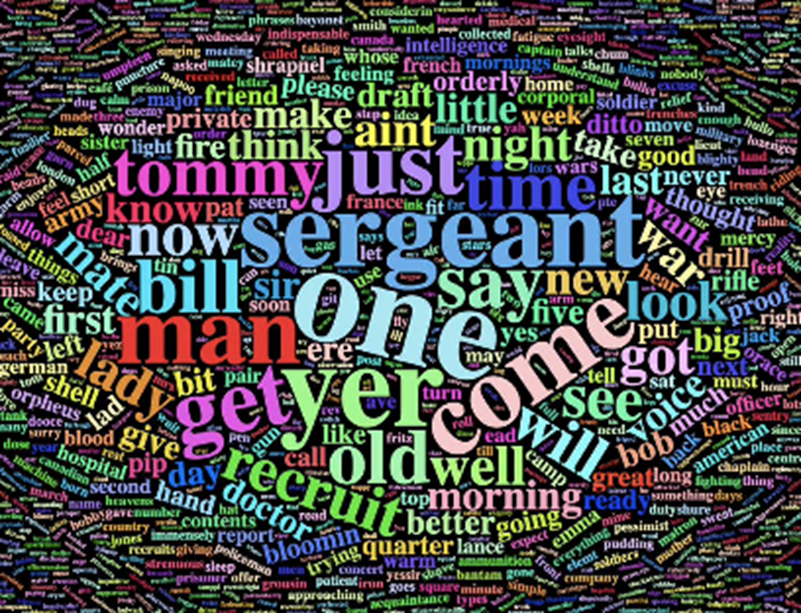
The Survey Results
In terms of composition, the cartoons of Blighty closely aligned to those of the overall survey. Over half the cartoons depicted life behind the lines – reflecting the experience of the common soldier.24 Over 70 percent of the cartoons featured Tommy Atkins, and a further 12 per cent featured an officer with their rank not stated – again, this was in line with the main corpus. In terms of influences, the cartoon was most likely to be based around wordplay, incorporating a quote from literature, or employing a proverb or stanza, such as the example from Private B Inward 2/19 Battalion, London Regiment (St Pancras) in Figure 4. There was a notable canon of literature that was quoted by all ranks, which included works from George Elliot, Charles Lamb, Rudyard Kipling, Alexander Pope and Robert Louis Stevenson. This love of literature was also reflected in the language used in cartoons. Across the 820 cartoons analysed there was a total of 15,173 words, thus on average each cartoon contained 19 words. For a modern–day comparison, entries to the open ‘#DrawChallenge’ cartoon competition (an irregular competition arranged on social media where a political theme is given as a prompt, organised by editorial cartoonist Martin Rowson) typically contain just 4.5 words, relying instead on visual humour.25 Removing stop– words and duplicates reveals a lexicon of 4,138 words. Using sentiment analysis, cross–referenced by date, reveals that while emotions changed throughout the course of the war, the language used remained positive throughout. This is where Blighty begins to differ, with a total of just 3,763 words used (still an average of 20 words per cartoon) and a much smaller lexicon of just 1,509 words, which are pictured in Figure 6. The reason for this can be explained by the editorial choices, especially when compared to trench journals, or unit magazines, whose main purpose was to foster esprit de corps. To do so, they regularly used the language of their members, and cartoons were no exception in this regard. The northeast and Scottish battalions in particular were full of local colloquialism such as ‘doon in ma dug–oot’, and troops overseas regularly incorporated the local language, such as adopting the Arabic يف ام’ [Mafeesh] meaning ‘There isn’t any’.26 This is in addition to ‘army–speak’, already rich in idioms and slang, all of which would have gone over the head of a London– based editor – especially one aiming to attract advertisers. Blighty further drifts away from the corpus in the choice of themes that appeared in its cartoons, a comparison of which is shown in Table 1.
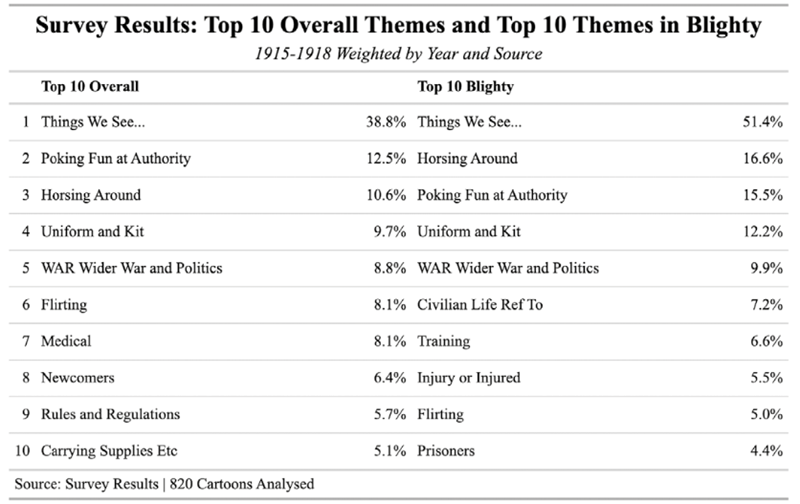
In terms of the top five themes, the dominant one across all sources, was ‘Things we see...’, cartoons that reflected the ordinary day–to–day scenes in camps, hospitals or the trenches, with the emphasis on the word ordinary – it was not the counterfactual or the extraordinary. Trench journals and hospital journals commonly contained a feature along the lines of ‘Camp Cackle’ (Growler), ‘Wheat and Chaff’ (Summerdown Camp) or ‘Things We See in Camp’ (Pennington Press), from which this theme takes its title. It is best summarised by one editor as: ‘The latest mess hall quip, light verse on kitchen police, cold shower baths, standing guard in the rain and other humorous subjects’, such as the parade scene in Figure 7.27 What is clear from these cartoons is that they served two purposes. The first gave an opportunity for the soldier to grouse – an important safety valve when it came to morale; and secondly it allowed them to gossip – an opportunity for a good chat, which in turn, as a social function, built cohesion.28
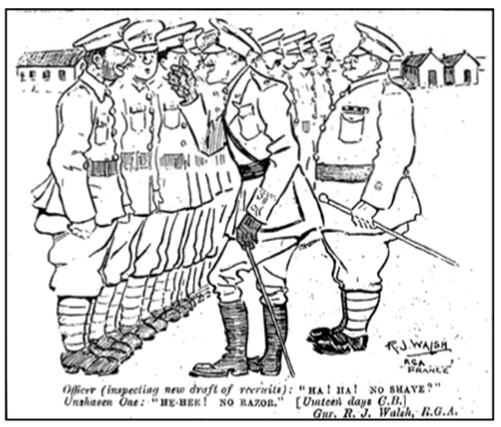
The next three themes ranked consistently across all sources in the survey over time and location and therefore it is fair to label these as the staples of army humour, they were: ‘Poking Fun at Authority’ – no one was out of bounds as long as it was a ‘good shot’, with the CO or Colonel being the butt of the joke in 7 percent of cartoons. ‘Horsing around’ – a simple type of humour designed to raise a laugh and the spirits, with jokes that were generally positive, with a dose of stoicism, although they could also be very dark. Finally, ‘Uniform and Kit’ – which centred around ill–fitting or missing kit items in 1915, and then more around finding unusual uses for items such as gas masks as the war went on.
‘Wider War and Politics’ is a more complicated theme to explain fully here, given space constraints, as it changed over the years, starting off with making fun of the recruitment drives and propaganda such as ‘Remember Belgium’, before attention turned inwards. In 1917, this theme was surpassed by another, the ‘The Long War’ and, unusual for the survey, the cartoons were overwhelmingly negative, reflecting, as other historians have observed, on the war weariness of 1917–1918.29 While cartoons on the ‘Long War’ continued into 1918, attention returned to the wider picture, along with what were initially post–war thoughts, to celebrating its end.
Blighty cartoons are fairly aligned to the general results in the top five overall, but the biggest differences are marked by what is absent. ‘Medical’ themed cartoons tended to focus around inoculations and the Number 9 pill, a laxative which was used as a ‘cure all’, which given the troops’ monotonous diet was probably a necessity.30 It was also a source of power play, especially when it came to ‘swinging the lead’ with troops seeing themselves ignored by the MO with genuine issues, and the MO (as well as stretchers bearers) accusing everyone of malingering. ‘Newcomers’ is a special case; this theme covered both recruits and relief and was the only theme in the entire survey to tail off entirely as the war went on. Army humour, in general, tended to punch upwards but here the newcomer was the target. There is evidence to suggest that pre–war, this was an established staple of army humour, however by the middle of 1916, it had started to become ill–received as the number of citizen soldiers increased. The editor of the Braganza, Royal West Surreys, had to go as far as issuing an apology for material published which came across as being too hard on new drafts.31 ‘Rules and Regulations’, another staple, was an opportunity for the Tommy to ‘grouse’, and as Jessica Meyer has said about writing in diaries, the men were not in control of the big picture, but by grousing in cartoons they could vent their frustrations.32 Finally, ‘Carrying Supplies’ was a theme that split into two groups: the first featured Tommy Atkins sweating as he carried his kit along with numerous similar cartoons pointing out the irony of being called ‘Light Infantry’. The second, related closely to a theme of ‘navigating the environment’, which depicted soldiers typically overloaded with kit trying to get from A to B and, for example, having to deal with ‘that’ loose trench board in ‘Pioneer Alley’, or avoiding telephone wires in ‘Drop Alley’.33 What these four themes broadly have in common is that the humour on display most likely made a lot more sense, and was funnier, if you had been there.
Given that Blighty was a ‘commercial’ endeavour, it is therefore not surprising to find that these elements were, for the most part, ignored. But, by omitting them, and putting the focus on other themes especially ‘Horsing around’ (+6%, Table 1), this creates an exaggeration of the actual humour of the average Tommy, and something more akin to the popular image of ‘Cheery Tommy Atkins’. ‘The Cheery Tommy’ had well–established roots as a pre–war archetype of ‘British humour’ defined by a calmness, stoicism and an inner bravery – popular in many stories, cartoons and jokes of the period – and was to be found in abundance at the music hall and in penny–publications. An important division, given class divides at the time, needs to be made regarding how this trope was employed, and by whom. The pre–war ‘Cheery Cockney’, or JM Barrie’s Admirable Crichton (1902), was a palatable, sanitised, stereotype for the upper and middle classes’ enjoyment, however, characters such as those in the magazine Picture Fun – especially popular with those in domestic service – showed a more heroic disposition, one which involved turning the humour on their masters.34 Given this duality in both reaching upper and lower classes, in modern marketing terms, it held mass appeal. Publications such as the Strand and Punch certainty tapped into it both during and after the war, to sell copies of their magazines and one of the most infamous examples of the Cheery Tommy was the ‘Arf a Mo Kaiser’ drawing done by Bert Thomas which was produced to sell cigarettes – in a thinly disguised vein for supporting the troops.35
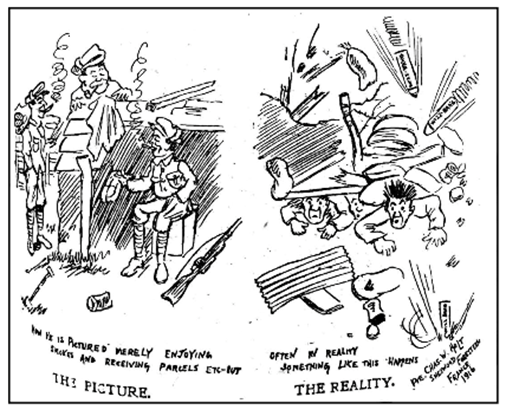
Behind the Cheery Tommy is a far more complex character, evidenced in part by the much larger lexicon that appeared outside Blighty, one which employed a more subtle, or more intimate, humour than the gallows humour commonly associated with the stereotype. It was just far more likely, overall, for there to be a joke about enjoying a parcel from home, than being on the receiving end of an artillery bombardment – a reverse of Private Chas Holts’ cartoon in Figure 8. However, unlike other depictions of the Cheery Tommy, Blighty’s cartoons were at least rooted in reality. Getting a joke published no doubt brought certain bragging rights, and with a prize of a guinea on offer, it is understandable that a bit of ‘flexing of the truth’ would have taken place. This is in contrast to trench journals and unit magazines, where typically at least one foot had to remain firmly in reality, and in stark contrast to hospital journals where class and propaganda meant it was often someone else’s idea that influenced what sort of Tommy should be on display – however, that is a topic for another day.
As an ongoing project, the author is attempting to identify the soldiers who contributed cartoons to the magazine. A work–in– progress list of contributors can be found at The 'Budding Bairnsfather's First World War Soldier Cartoonist Published in Blighty.
References
1. Charles Bird, ‘From Home to the Charge: A Psychological Study of the Soldier’, The American Journal of Psychology, 28(3) (1917); Peter Hart & Gary Bain, Laugh or Cry: The British Soldier on the Western Front 1914–1918 (Barnsley: Pen & Sword, 2022).
2. Thomas Milton Kemnitz, ‘The Cartoon as a Historical Source’, The Journal of Interdisciplinary History, 4 (1) (1973); Peter Burke, Eyewitnessing: The Uses of Images as Historical Evidence (New York: Cornell University, 2001), p.81.
3. Scott McCloud, Understanding Comics: The Invisible Art (New York: Cornell Press, 2001), pp.84–85, 94–116,138–162.
4. For an example, see Lachan R. Moyle, ‘Drawing Conclusions: An imagological survey of Britain and Germany and the Germans in German and British cartoons and caricatures, 1945–2000 (Ph D, University Osnabrück, 2002).
5. Ismael Manterola Ispizua, Raemaekers’ Cartoons: British Propaganda in Spain and the Basque Country during the First World War (Bilbao: Universidad del País Vasco, 2012); Jane Chapman, Anna Hoyles, Anna Kerr & Andrew Sheriff, Comics and the World Wars: A Cultural Record (New York: Palgrave, 2015).
6. Wolfkang Hünig, British and German Cartoons as Weapons in World War I (Frankfurt: Peter Lang Gmbh, 2002).
7. ‘Role Up’: data analysis term for aggregating data either horizontally, vertically, or both, into totals or subtotals.
8. Military Mail: The Organ of the Regular and Territorial Forces and the National Reserve,12 May 1916, p.10; The Observer, 23 July 1916, p.5.
9. Worthing Herald, 25 June 1921, p.3; Paul Ferris, The House of Northcliffe: The Harmsworths of Fleet Street (London: Weidenfeld and Nicolson, 1971), p.79.
10. Blighty: A Budget Humour from Home, 31 May 1916, p.1.
11. Blighty, 1 September 1918, p.20.
12. Blighty, 19 February 1819, p.14.
13. Blighty, 5 March 1919, p.1; The Cologne Post: A Daily Paper. Published by the Army of the Rhine, 25 July 1920, p.1.
14. Truth, 7 June 1916, p.953.
15. The magazine featured a list of donors behind each issue; the amounts donated for volume 55, 20 June 1917, totalled £570.
16. Truth, 14 November 1917, p.12.
17. https://irishmediahistory.com/2016/01/07/ramsay– 18 colles–1862–1919/, retrieved 23 March 2023.
18. Fulham Chronicle, 28 October 1904, p.8.
19. Truth, 10 September 1919, p.12; The Saturday Review, 26 February 1921, p.173; Daily Gazette for Middlesbrough, 22 September 1939, p.7.
20. The Outpost: Magazine of the 17th Service (Glasgow Chamber of Commerce) Battalion, Highland Light Infantry, 1 March 1916. p.29; The Outpost, 1 March 1917. p.156; The Outpost, 1 April 1917, p.228.
21. West Sussex Country Times, 18 November 1916, p.4.
22. https://www.jewsfww.uk/percy–adolph–cannot–2270.php, retrieved 1 March 2023.
23. Liddle Collection, LIDDLE/WW1/GS/0371, H. Cotton personal papers.
24. Richard Grayson, ‘A Life in the Trenches? The Use of Operation War Diary and Crowdsourcing Methods to Provide an Understanding of the British Army’s Day–to–Day Life on the Western Front’, British Journal of Military History, 2(2)
25. https://www.martinrowson.com/draw, retrieved 29 November 2022, 100 cartoons sampled at random.
26. For an example, see Kia Ora Coo–ee News, 15 August 1918, References p.5.
27. Summerdown Camp Journal, Representative Organ of Summerdown Military Convalescent Hospital, 25 September 1915, p.14 The Growler: The Organ of the 16th Service Battalion. Northumberland Fusiliers, 1 March 1916, p.2; The Outpost, 1 February 1918, p.124.; Wadsworth Gas–Attack, 23 November 1917. p.4.
28. Matthew Feinberg, Robb Willer, & Michael Schultz, ‘Gossip and Ostracism Promote Cooperation in Groups’, Psychological Science, 25(3) (2014), p.663.
29. David Stevenson, With our Backs to the Wall: Victory and Defeat in 1918 (London: Penguin Group, 2011), p.506.
30. Fiona Reid, Medicine in First World War Europe: Soldiers, Medics, Pacifists (London: Bloomsbury, 2017), p.136.
31. The Braganza: Being the Chronicles of the 1/4th Bn. The Queen's Regt (Royal West Surrey Regiment),1 March 1917, p.1.
32. Jessica Meyer, Masculinity, and the First World War in Britain (New York: Palgrave Macmillan, 2009), p.49.
33. Liddle Collection, LIDDLE/WW1/GS/061, Herbert Gibson Sketchbook, 1916.
34. Lucy Delap, ‘Kitchen–Sink Laughter: Domestic Service Humour in Twentieth–Century Britain’, Journal of British Studies, 49(3) (2010), pp.636–638
35. Emily Anderson, ‘Humour and Representation in British Literature of the First World War (1914–18)’ (Ph D, Newcastle University, 2019), pp.125–134. For other examples, both during and post war, see Frederick Treves, (ed.), Made in the Trenches (London: George Allen, 1916); YMCA, Told in the Huts; The Y.M.C.A. Gift Book, Contributed by Soldiers & War Workers (London: Jarrod & Sons, 1916), London Evening News (ed.), 500 of the best Cockney War Stories (London: Associated Press, 1921).





